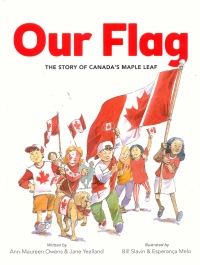| ________________
CM . . .
. Volume XXI Number 17. . . .January 9, 2015
excerpt:
Our Flag: The Story of Canada’s Maple Leaf is an updated version of Canada’s Maple Leaf: The Story of Our Flag published in 1999. This nonfiction text for grades 3-6 provides information on a popular research area for junior students although the update is minimal in terms of the book’s format and style. Like Canada’s Maple Leaf, Our Flag is a valuable resource for classroom use by young researchers looking to learn about the history of flags in Canada. The text includes a brief overview of international flags, a history of flags, and many sections on the changes that occurred to get to Canada’s current flag. There is also a section explaining the symbolism behind the flags of each province and territory. In general, each section is two pages long. While the publisher lists the suggested grade level as 2-5, many passages, including the excerpt, would be difficult for younger readers. The information presented to readers is appropriate for grades 3-6. The predominantly watercolour illustrations are decorative but do help clarify some difficult or confusing parts of the text, such as the section on ensigns and jacks. Narrative sections, like “Joan O’Malley’s Flag”, as well as simple craft instructions to make a Canadian flag and signal flags, offer more access points for readers to become engaged and find something that interests them within the pages of the book. Our Flag does cover a wide variety of information about the Canadian flag; however, it is not very friendly as a quick, independent reference tool for young researchers. While it does have an index, its lack of a glossary or bolded terms, and relatively few subheadings can make the technical information being presented seem confusing or overwhelming. Furthermore, there are areas where the text assumes readers have some basic historical knowledge (for instance, Canada’s history as a British colony) to make sense of the new information being presented. Readers who do not know or remember this fact may find references to Canada and Britain confusing or misleading. As an information text, there are also some questionable omissions of details or inconsistency in format that may lead to misunderstanding by young readers. For example, in the section “First Flags Over Canada”, details, including dates, are provided for when various flags were flown in what are now Canada’s provinces, but no date is given for when American trading forts under the American flag operated illegally in Alberta. As an updated text, the back cover of Our Flag now highlights that the book includes “the latest online resources.” Teachers or students looking for unique and engaging resources to connect with the text will find this statement to be an exaggeration. The book only lists four “flag friendly” Internet sites, including two links to Canadian Heritage sites and the link to the classic Heritage Minute video on the flag, all of which are found with a basic Internet search of Canada flag. Overall, this resource continues to do what the original did: provide young researchers with a wide variety of information on a subject where few similar books exist. While its information is now updated to take into account any changes in the last 15 years, its format as an information text seems a bit stuck in the last millennium and misses the chance to grow with the information seeking skills of young readers. Recommended with Reservations. Beth Wilcox is a graduate from the MA in Children’s Literature program at the University of British Columbia and a teacher librarian in Prince George, BC.
To comment
on this title or this review, send mail to cm@umanitoba.ca.
Copyright © the Manitoba Library Association. Reproduction for personal
use is permitted only if this copyright notice is maintained. Any
other reproduction is prohibited without permission.
Next Review |
Table of Contents for This Issue
- January 9, 2015. |
